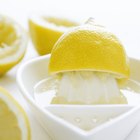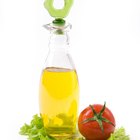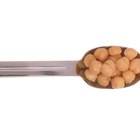
View Stock/View Stock/Getty Images
Humans have consumed milk for more than 10,000 years, but it wasn't until the mid-1800s that scientists figured out how to remove water from milk, creating powdered milk. Skim-milk powder, which has had fat as well as water removed, is available in almost any supermarket, and can be a good addition to your healthy lifestyle.
Manufacture
Powdered skim milk is made in large facilities, according to Mark Silvas, the national sales and marketing manager for the Humboldt Creamery, a producer of dry milk, who shared his knowledge with USA Emergency Supply. First, fat is removed from the milk via skimming. Then the milk is cooked until about 1/3 of its water content has evaporated. Milk is dried by passing it through a high-pressure nozzle or atomization system, which breaks the milk into tiny drops that then fall at least three stories, drying out as they fall.
Serving Size
Serving size varies depending on how you plan to use powdered milk. The usual serving is 1/3 cup, which when mixed with a cup of milk makes 1 cup of liquid skim milk, according to the USDA Food and Nutrition Database. However, if you are using dry milk as a substitute for another ingredient, the amount may change. For example, 1-1/8 cup powdered nonfat dry milk mixed with ½ cup of water and 1 tbsp. of vinegar can be used as a substitute for sour cream, according to the Colorado State University Extension.
Nutrients
One-third cup of powdered skim milk has 80 calories, .2g of total fat, .1g of saturated fat, 4mg of cholesterol, 123mg of sodium, 11.7g of sugar, no fiber and 7.9g of protein. That is less than 1 percent of the daily value for fat, exactly 1 percent of the daily value for saturated fat, 4 percent of the daily value for carbohydrates and 5 percent of the daily value for sodium.
Vitamins and Minerals
One-third cup of powdered skim milk has 276.2mg of calcium, which is well-known for its role in bone health. The same amount also has 382.6mg of potassium, which can help keep your blood pressure under control, according to the Centers for Disease Control. Some brands are also fortified with vitamin A and vitamin D.
Benefits
Powdered milk has less fat than 1 percent, 2 percent or whole milk, which can help you keep your fat intake under control. It is less expensive than fluid milk, according to Mary Webber, author of "The Frugal Family's Kitchen Book." Also, powdered milk is shelf stable, so you won't have to worry about it going bad.
Considerations
You may not like the taste of reconstituted powdered milk for drinking or on cereal, especially if you're used to higher-fat milks. Deal with the taste problem by using powdered skim milk in recipes that will hide the taste, such as hot cocoa, or by using it in cooking or baking. If you do use it for baking, be aware that milk is on the FDA's list of the top eight most common allergens. If you're making breads, cookies or cakes you intend to share with others, ask about dairy allergies.
Related Articles

How to Substitute Dry Milk for ...

How to Use Powdered Milk for Baking

Can I Substitute Dry Milk Powder for ...

How to Substitute With Dry Milk

How to Substitute Powdered Coffee ...

How to Add Oil to Dry Powdered Milk to ...

Heavy Cream vs. Milk in Baking

How Much Powdered Milk Makes 1 Cup?
Differences Between Instant & ...

Can I Dilute Whipping Cream to Sub Milk?

How to Replace Milk and Butter in Baked ...

How to Purchase Milk Crates

How Do I Curdle Soy Milk With Lemon ...

Can You Substitute Shortening for ...

Milk of Magnesia Treatment for Acne

History of the Milk Bath

A List of Leavening Agents

How to Cook With Buttermilk Powder

How to Cook Dry Garbanzos in a Crock Pot

How to Make Easy Homemade Hot Cocoa Mix ...
References
Writer Bio
Melanie Greenwood has been a freelance writer since 2010. Her work has appeared in "The Denver Post" as well as various online publications. She resides in northern Colorado and she works helping to care for elderly and at-risk individuals. Greenwood holds a Bachelor of Arts in pastoral leadership from Bethany University in California.
Photo Credits
View Stock/View Stock/Getty Images